History and features of the Scythian gold
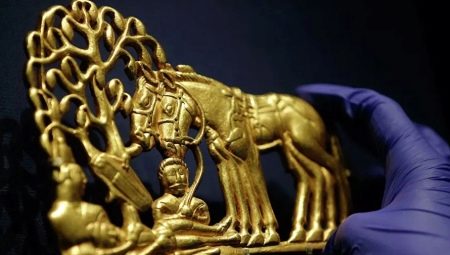
Legends about the gold of the Scythians have haunted archaeologists for many years. Mention about them can be found even in Herodotus. At a certain period, the Scythians lived on the territory of Russia and Ukraine, therefore, the main part of the treasures is located in these countries.

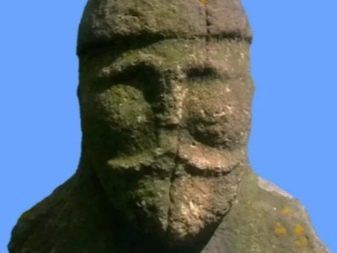
History
The first gold items of the Scythians appeared at the end of the Bronze Age. During this period, the craftsmen have already learned how to process metal with high quality. To understand the value of the Scythian gold, it is necessary to first understand who these people themselves were.
According to ancient sources, the main Scythian tribes lived on the territory of the steppes of the Northern Black Sea region.
Their origin is also controversial. It is believed that the first Scythians lived on the banks of the Dnieper River. The longest time the tribes of the Scythians were on the territory of the Crimea. However, back in the 3rd century BC, they were practically destroyed by the Goth troops.
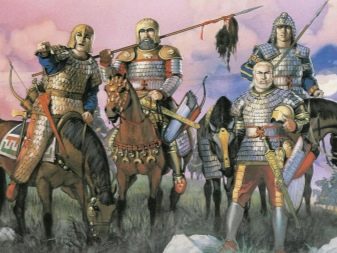
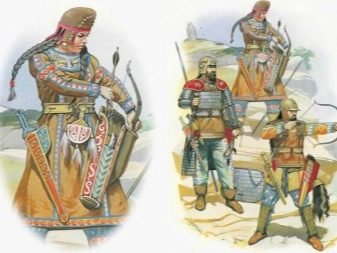
A distinctive culture was created by the Scythians. They left the memory of themselves due to the fact that they buried representatives of the nobility with great honors. With them the most expensive gold objects were placed in the tombs, which were supposed to help them live in the afterlife with the same luxury as during life.
It is because of this that many people are looking for the tombs of the Scythians and studying them. However, some of them are frightened by the myths about spells imposed on all jewelry buried in the ground.
After all, some archaeologists who took part in the excavations and took expensive items from there died in such mounds.
Because of this stories appeared that when a person found gold jewelry, he had a heart attack. Those of the archaeologists who survived were sick all their lives.This suggests that you should not disturb the dead Scythians during their eternal sleep.
However, this did not stop everyone. Therefore, a huge amount of gold and other expensive things were found and sent for storage to several large museums in the world at once.
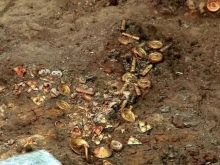
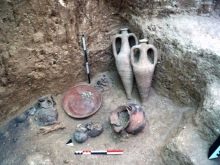
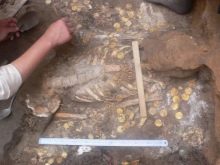
Common decorations and images
There are a large number of ornaments that have been found in Scythian burial mounds. All of them are not only beautiful, but also have a certain meaning. Among the finds on display in museums, the most popular are several interesting exhibits.
- The Museum of Greece contains earrings made in the 4th century BC. Their splendor is simply striking in its beauty.
- In the collection in the Hermitage, you can see a gold disc with the heads of Medusa. Almost all visitors cannot take their eyes off these "beauties".
- In the same museum, there are many golden vases depicting a variety of everyday scenes.
- Another Hermitage exhibit that is simply impossible to pass by is a figurine of a golden deer.
- The Hermitage collection also has a hair clip made in the shape of a griffin, which tears apart a goat.
- In addition, there you can also see a golden comb, on which the image of military battles flaunts.
- In the Crimean collection you can find an amazing golden diadem, which was created 150 years before our era.
- There is also a necklace on which there is an image of interesting everyday scenes.
- In this listing, it is impossible to ignore the amulet, on which you can see the image of the Scythian goddess of the land Api, who patronized fertility and prosperity.
- In addition, there is also a statuette of the golden "Winged Bull", which was sold at one of the auctions in Paris. Made it in the 5th century BC.
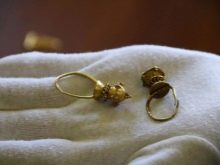
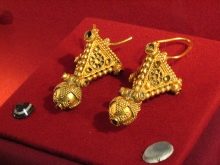
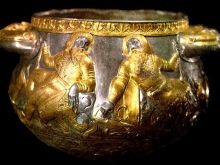
The royal pectoral is also worthy of special attention. It was found in the last century, namely: June 21, 1971 in the Tolstaya Mogila mound. The Scythians made this burial in the area of the Dnieper River. The well-known Mozolevsky was in charge of the expedition.
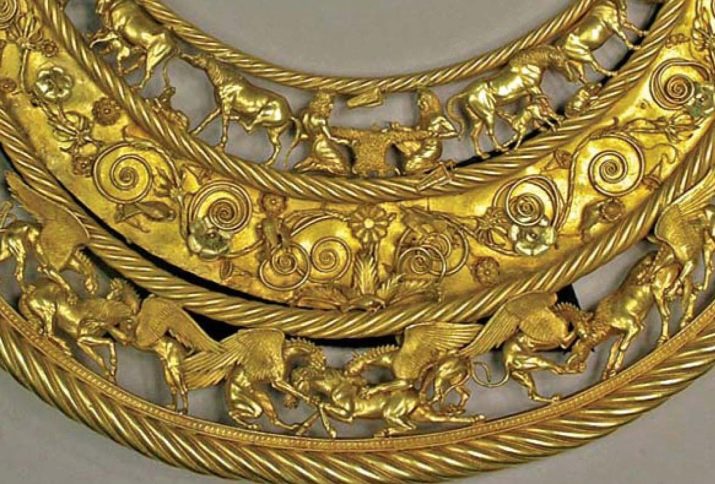
The members of this expedition discovered a lot of gold jewelry of unusual shape, but the most valuable among them was the pectoral. Its mass is 1 kilogram and 140 grams, and its diameter is 30 centimeters. The shape of this decoration resembles a crescent moon. The composition itself has 3 tiers, which are separated by pipes. In addition, they are decorated with pseudo-grain.
On the uppermost tier, scenes of everyday life with the participation of people and various animals are captured. So, in the center are images of half-naked men holding a sheep's skin in their hands. On the right and left sides, you can see horses with foals, as well as cows with calves. Immediately behind them are the Scythians milking the animals. All this makes it possible to understand how people lived approximately in those days. Therefore, the pectoral is of great value.
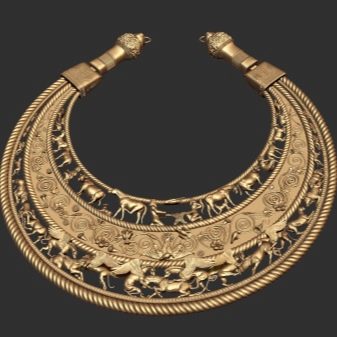

On the middle tier, you can see images of flowers and plant shoots, including birds. On the lowest tier, hunting scenes are captured. Many experts believe that experienced Greek craftsmen created such a decoration as a pectoral directly by order of the Scythians. Scientists are still debating the meaning of the images.
Some of them claim that the legend of the golden fleece is depicted on the pectoral, others insist that these are scenes from the ordinary life of the Scythians.
The pectoral is located in the Kiev Museum of Historical Treasures of Ukraine.
Locations
Many gold jewelry was found directly in the burial places of the Scythian nobility, that is, in the mounds. They were all of great value. The most valuable finds of mounds were made in the Black Sea region - in Kul-Oba, Chertomlyk and Solokha. All representatives of world museums dream about them today.
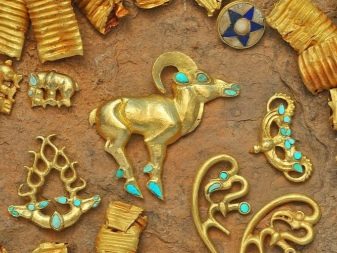

Kurgan Kul-Oba
If we translate this name from the Tatar language, then it means "a hill of ash". The burial was located on a mountain ridge that runs from Mount Mithridates. In 1981, several archaeologists began researching this mound. The tomb itself was found by chance when a stone fell.
A rather significant burial was discovered in it, which was made according to the Scythian rite. All the fossil finds made up the core of the collection of antiquities kept in the Hermitage.
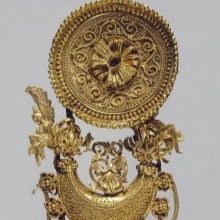
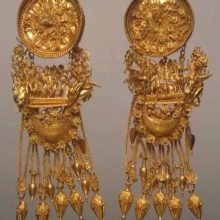
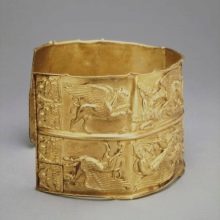
Kurgan with "Issyk letter"
This discovery was made near Almaty in 1969. Kazakh scientists were very happy with the findings. After all, the mound was completely untouched. Thanks to this, they received a large number of artifacts at their disposal.
According to experts, this burial belonged to the prince of the Scythians. This was found out thanks to the clothing found on the buried person, which contained fragments of the "Issyk letter". Only a specialist from the Institute of Archeology could read it. In addition, more than 4 thousand gold objects were found in the mound, among which there was a silver bowl.
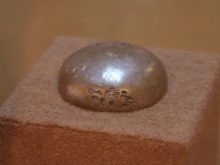

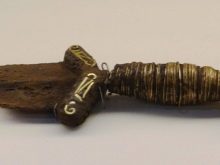
Kurgan Ych-Oba
This female burial, located near Kerch, was found in the last century - in 1965. Two women were buried in the tomb, whose remains were discovered by archaeologists. The expedition was headed by Kirilin D.S.
A lot of gold jewelry was found along with the remains. Let's list some of them:
- earrings made in the form of a sphinx;
- diadem with patterns, as well as relief images;
- scarab ring;
- plaques depicting various mythical animals, for example, a pegasus or an eagle, as well as lotus flowers;
- winged goddess;
- beads of incredible beauty;
- bells of unusual shape and much more.
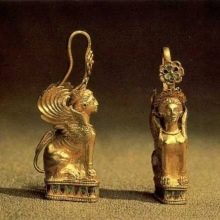
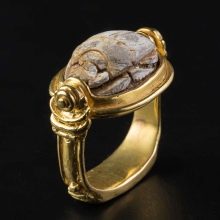
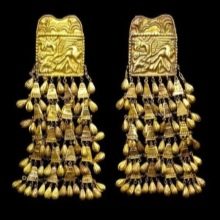
Mound of Solokha
Excavations of this burial, located near the city of Nikopol, were made back in 1913. The expedition was led by the Russian archaeologist Nikolai Ivanovich Veselovsky. A lot of gold items were found here.
Among them, it is worth noting a gold badge made in the shape of a deer. In ancient times, she was on the shield of some Scythian warrior from a wealthy class.

Where is the gold now?
One of the main parts of the Scythian gold, including various jewelry, until recently was in the museums of the Crimea. However, in 2014, almost all of the Scythian Crimean heritage was exported to the Netherlands for an exhibition.
The collection contained a large number of items - more than 500 items. In 2016, some of the exhibits were returned to museums in Ukraine. Their number was only 19 items. The remaining 565 items, consisting of 2,111 units, are kept today in the Amsterdam Museum. The collection is estimated at 10 million euros.

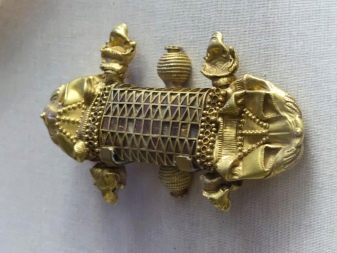
In 2010, after the completion of the reconstruction, the exposition “Ancient Siberia. Fifth Pazyryk Kurgan ". It includes not only products made of wood or fabric, but also gold items. This exhibition has been planned for several years. Therefore, it turned out to be very thoughtful and impressive.
The exhibition was based on the famous collection of Peter the Great. She is considered one of the very first in Russia. In addition, a large number of items from the Scythian burials of the Black Sea region, which were found in the 19th century, could be seen there. However, the most important part of the exposition was occupied by finds already made by modern archaeologists from the Hermitage.
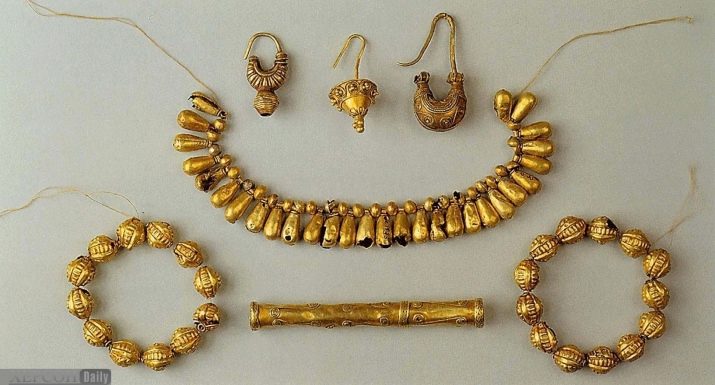
A large number of gold Scythian jewelry is in the world famous museum of St. Petersburg - in the Hermitage. The collection is considered the richest for various items of the Scythian times. Thanks to this exposition, one can understand how diverse the life of the Scythian people was.
In 2017, an exhibition was organized in London brought from the Hermitage. More than 850 items were sent there, which represent the culture of the Scythian people in the period from the VIII century BC to the IV century AD.
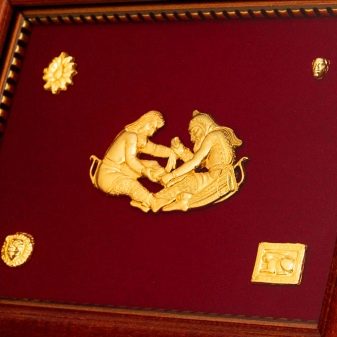
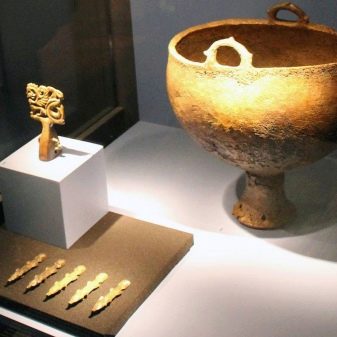
Summing up, we can say that the representatives of the Scythians were very rich people. This is evidenced by various objects recovered at different times from Scythian tombs.Therefore, it remains only to be glad that this ancient people managed, at least in such a strange way for modern times, to preserve the memory of their life.
Who are the Scythians and what is Scythian gold, see the video.








